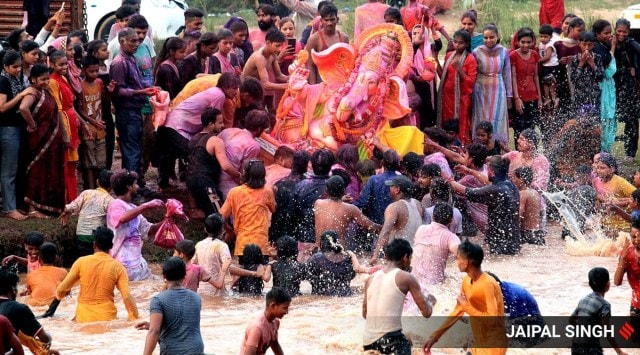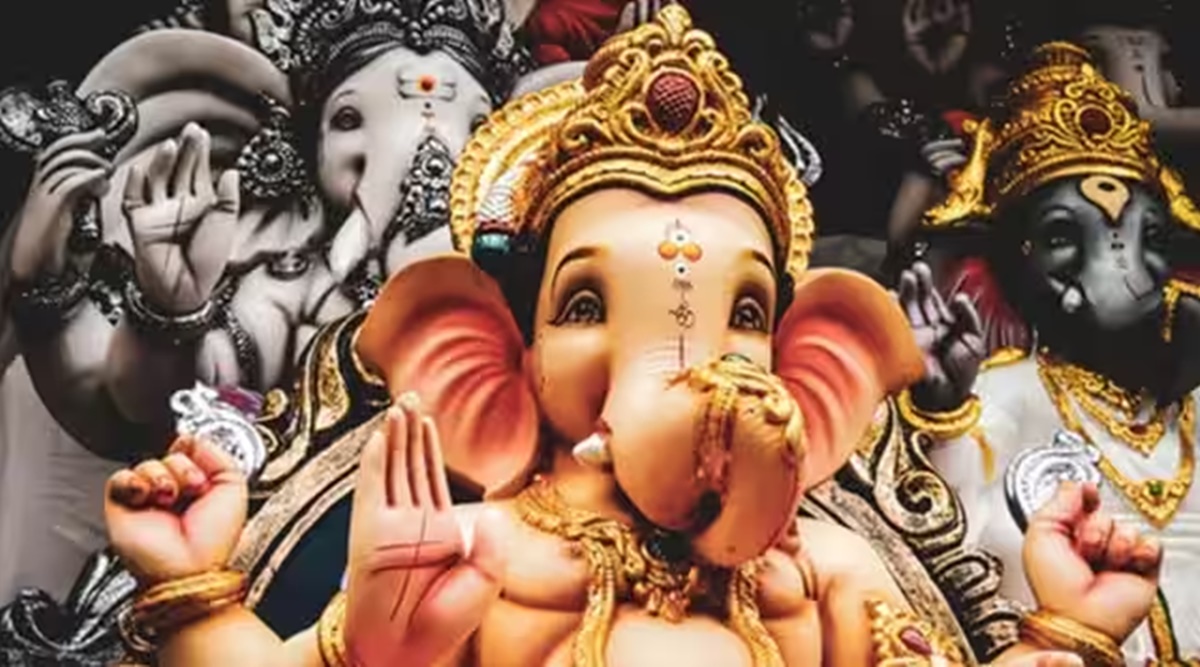📣 For more lifestyle news, click here to join our WhatsApp Channel and also follow us on Instagram
Ganesh Chaturthi 2023: Know the proper guidelines to perform Ganesh Puja and Visarjan
As we gear up for the festivities, here are few things about the puja and visarjan one must keep in mind, according to Pandit Jagannath Guruji.
 Devotees immerse a Ganesh Idol in Ghagger River in Punjab's Panchkula on Friday, September 09. (Express Photo by Jaipal Singh)
Devotees immerse a Ganesh Idol in Ghagger River in Punjab's Panchkula on Friday, September 09. (Express Photo by Jaipal Singh) One of the biggest and most-revered festivals in the country is finally here! Every year, Ganesh Chaturthi is celebrated with great pomp and fervour across the nation. Celebrated as Lord Ganesha’s birth anniversary, this year the ten-day festival will begin on September 19, and end on September 28.
As we gear up for the festivities, here are a few things about the puja and visarjan one must keep in mind, according to Pandit Jagannath Guruji. He explained that there are various stages of the Ganesh Puja, including:
*Prana Pratishtha (Invocation of life): This is the first and most important stage of the puja. The priest invokes the life force into the Ganesha idol through mantras and rituals.
*Shhodashopachara (16-fold worship): This is the main stage of the puja. The Ganesha idol is offered 16 different types of offerings, such as flowers, fruits, sweets, and prayers.
*Abhishekam (Bathing): The Ganesha idol is bathed with holy water, milk, and other liquids.
*Aarti (Worship with light): The Ganesha idol is worshipped with light from a lamp or diya.
*Vastradhana (Dressing): The Ganesha idol is dressed in new clothes and ornaments.
*Naivedya (Offering of food): The Ganesha idol is offered food, such as modaks, laddoos, and other sweets.
*Hawan (Fire ritual): A hawan is performed to invoke the blessings of the gods.
*Visarjan (Immersion): The Ganesha idol is immersed in a river or ocean, symbolising the return of Ganesha to the divine realm.
There are also some necessary materials required for the Ganesh Puja, which can vary depending on the region and family traditions.
“The Ganesh idol is the central focus of the puja, which can be made of clay, wood or metal. Other materials needed to complete the puja include a thali, flowers, fruits, sweets, water, milk, ghee, incense sticks, sandalwood paste, vermilion, Akshata (rice grains), durva grass (sacred grass), coconut and money,” he said.
One of the most important days of Ganesh Chaturthi is the visarjan, a sacred ritual in Hinduism, which involves the immersion of a Ganesha idol. According to Pandit Ji, there are certain guidelines we need to follow while performing the ritual, such as:
 Ganesh Chaturthi Celebrations: Ganesh Chaturthi is one of the most auspicious festivals in India. (Photo: Unsplash)
Ganesh Chaturthi Celebrations: Ganesh Chaturthi is one of the most auspicious festivals in India. (Photo: Unsplash)
*Choose a suitable location: Select a natural water body such as a river, lake, or ocean for immersion. Using artificial tanks or local ponds should be avoided whenever possible to ensure environmental sustainability.
*Timing: Ganesh idol immersion typically takes place on the final day of the Ganesh Chaturthi festival, which can vary but is often observed on the tenth day. Check local customs and the festival calendar for the specific date and time.
*Direction of immersion: While immersing the idol, face the idol towards the North or East direction. This is considered auspicious in Hindu tradition.
*Procession and chanting: Begin the immersion procession by carrying the idol carefully towards the water body. Chant Ganesha mantras or devotional songs during the procession to express devotion and gratitude.
*Flower and coconut offering: Before immersion, place fresh flowers at the feet of the idol and offer prayers to seek blessings. Break a coconut as a symbol of surrendering one’s ego to the divine.
*Kumkum (Vermilion): Apply a small dot of kumkum on the idol’s forehead or the spot where the third eye would be, symbolising the awakening of inner wisdom.
*Aarti with camphor: Perform a final Aarti with lit camphor or diya, moving it in a clockwise circle in front of the idol. This represents the removal of darkness from your life.
*Gentle immersion: Gently immerse the Ganesha idol in the water. It’s customary to immerse the idol partially or fully, depending on the depth of the water body. While doing so, bid farewell to Lord Ganesha with reverence.
*Witness the dissolution: Watch the idol slowly dissolve in the water, symbolising Lord Ganesha’s return to his divine abode.
*Environmental considerations: Ensure that the materials used for the idol and decorations are eco-friendly and do not harm the environment. Avoid idols made from non-biodegradable materials.
*Collect floating materials: After immersion, collect any materials like flowers or coconuts that may float back to the shore. These materials are considered sacred, and their collection is a part of the ritual.
*Clean the surroundings: It’s essential to clean the area around the immersion site and dispose of waste responsibly, leaving the environment as pristine as possible.
*Continue with festivities: Return to your home or community with a sense of fulfilment and continue celebrating the festival with prayers, bhajans (devotional songs), and feasting.
📣 For more lifestyle news, follow us on Instagram | Twitter | Facebook and don’t miss out on the latest updates!
📣 For more lifestyle news, click here to join our WhatsApp Channel and also follow us on Instagram



- 0118 hours ago
- 021 day ago
- 031 day ago
- 0417 hours ago
- 051 day ago
























